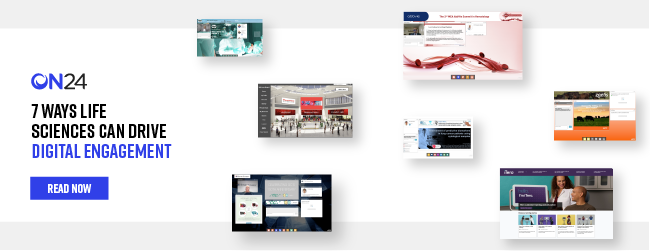4 Digital Challenges Life Sciences Face After COVID-19

There are always digital challenges life sciences face in its day-to-day work. But, within less than a year, the industry had to move how it sells, communicates and educates its audiences entirely online.
That is on top of transforming the entire industry to not only face the challenges posed by COVID-19, but maintain productivity as well.
So, it should be no surprise the life sciences industry faces different digital marketing challenges today than what they faced a little more than a year ago.
Ready to see how digital experiences can enhance your digital marketing? Register for our daily demo now. [Register Now.]
The State of the Life Science Industry Then and Now
First, let’s establish some facts. Before COVID-19, life science professionals knew they needed to invest more in both technology and digital tools thanks to patient trends. According to research published by McKinsey in January 2020, these trends include:
-
- Patient engagement with healthcare and the expectations of consumer-like experiences.
- Advances in decision-making processes thanks to analytics, automation and cloud computing.
- Development and scale of personalized medicine to improve patient outcomes.
- The importance of digital ecosystems.
- How nontraditional organizations, usually in the technology sector, impact the healthcare industry.
These developments put a lot of pressure on the traditional life science company. Then COVID-19 arrived and accelerated the above trends with a few added curveballs. Let’s take a look now:
Challenge 1: Life Science Adapts to Remote Work
 The COVID-19 pandemic necessitated lockdowns and shelter-in-place orders for non-essential personnel — even professionals in the life sciences industry. This sudden shift to a remote workforce will have long-term implications.
The COVID-19 pandemic necessitated lockdowns and shelter-in-place orders for non-essential personnel — even professionals in the life sciences industry. This sudden shift to a remote workforce will have long-term implications.
For example, according to Deloitte’s 2021 Global Life Sciences Outlook report, 64% of life sciences professionals say they’re willing to spend some hours in the workplace. Note that 46% of respondents did not share the same sentiment, and those willing to return to the workplace say they’re only willing to do so for “some hours.”
A hybrid workforce, one familiar with remote work tools like Microsoft Teams, Slack and more, will be necessary.
This remote-work standard also implies that the healthcare professionals that life sciences organizations market to. As a result, professional-grade digital marketing tools — those empowering organizations to craft digital experiences and collaborate with audiences — are a necessity.
A digital-first posture should also be beneficial for life sciences organizations as a whole. According to Deloitte, 90% of employers say flexible schedules haven’t productivity and that a remote posture could help organizations identify and recruit talent from across the globe.
Challenge 2: Communicating and Empathizing in a Digital-First World

Healthcare professionals are a busy bunch. So are patients. It’s rare for either of these two groups to have the time, energy and attention to conduct serious research on a pharmaceutical company’s offerings.
That’s why it’s so crucial for life sciences organizations to have an empathetic approach to digital experiences.
But building an empathetic experience means having a key understanding of what an audience wants and needs from a digital touchpoint. In life sciences, these often boil down to:
-
- Patient education
- Education on patient care for a specific product or technique
- Education on trials, trial results and healthcare technology
- Intellectual discussion around new developments within a field
- The ability to do nearly all of this on a schedule that fits within the audience’s availability
If that sounds like a tall order, that’s because it is.
But providing these experiences — and learning more about audiences in the process — isn’t impossible.
Three Digital Experience Tools for Life Sciences
Webinars – One of the most powerful instruments in a digital marketer’s toolbox is the humble webinar. Done right, these experiences can capture audience attention upwards of an hour, engage attendees through polls, surveys and chats, and even provide an organization’s sales representatives with attendee insights, like questions they’ve had about a product or service. They can even offer HCPs with continuing education credits.
Webinars don’t have to be one-off events. In fact, as our 2021 Webinar Benchmarks Report shows, many webinars provide valuable engagement (up to 45% of a webinar’s attendees watch events on-demand) long after a live event is over.
Content Hubs – Audiences want to consume your content. Content hubs provide you with an easy, scalable way to organize that content so your audience can find what they need. Organize multimedia elements, resources and more in content hubs specifically for HCPs. This way, you can provide an easy-to-access resource that’s available with the most up-to-date, pertinent information on demand.
Personalized Pages – Sometimes, an account or category needs a special touch. Provide those white-glove experiences with pages filled with information just for them.
Challenge 3: Running Virtual Trials and Remote Research

Conducting research during a pandemic is, well, difficult to say the least. Employee health is paramount, but a lot of research simply isn’t remote-friendly.
Principal investigators had to learn how to establish in-lab requirements — from procedures and protocols to behavior like mask-wearing — while training technicians and researchers on remote work best practices. They also needed to learn how they could glean meaningful insights from data collected in imperfect situations.
In fact, according to McKinsey, pharmaceutical companies are researching how to build resilience into clinical trials. Central to this is identifying opportunities to virtualize as much as possible. Opportunities include:
-
- Bio-stats reviews to identify salvageable data
- Adapting telehealth innovations for remote consultation and monitoring
- Direct-to-patient drug delivery
Additionally, virtual trials could help pharmaceutical companies lower the barrier to participation in trials. According to Clinical Leader, the net result would be a boost to inclusivity and population demographics in trials overall.
Challenge 4: Creating Impactful Digital Environments

The need for life sciences to provide a strong digital presence was important before the pandemic. It’s even more important now as organizations adopt a semi-permanent remote workforce and client base.
There’s a bit of a catch-22 when it comes to digital success. That’s because the key to digital success is knowing when, where and how to connect with your audience. But you can’t know all of those elements unless you create experiences you know they’ll engage with.
So, how can a digital marketer in the life sciences industry overcome this hurdle?
Well, it comes down to having a solid strategy behind your content marketing efforts. After all, the content you create will act as the foundation for your digital experiences.
For example, simply creating a general landing page for physicians isn’t going to provide your audience with the information they’re looking for. However, creating a page specifically for oncologists specializing in multiple myeloma will.
Four Tips for Building a Digital Experience in Life Sciences
Collect and consolidate information relevant to audiences — Collect items like datasheets, brochures, field trends, and even protocols that’ll impact your audience.
Have a brand for your audience — Make sure your audience knows what they’re looking for with branding that stands out. If you have multiple audiences, consider slightly adjusting brand colors so visitors can identify content at a glance.
Unify your data — Each digital touchpoint should provide insight into your audience. Capitalize on this data by ensuring your experiences are connected to an analytical tool or CRM. This way, you can gather insights and adjust your experiences for maximum impact.
Partner up — Producing big pillar content like webinars is essential. Make webinar production and creation easier by teaming up with strategic partners or key opinion leaders to produce content that resonates with your target audience and drives conversions.
Digital Is Now
The need to drive digital transformation in the life sciences industry has never been more acute. So remember to slow down, think through your digital marketing strategy and adjust your marketing strategy to make room for a digital world.
Good luck!

